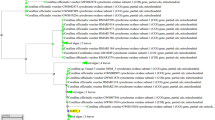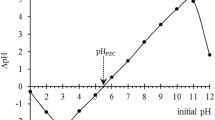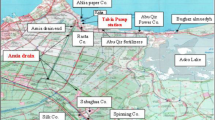Abstract
The revolutionary applications of seaweed extracts show promising potential to change the way of research and commercial applications based on seaweed. A commercial liquid extract (True Algae Max, TAM®), derived from three seaweed species (Pterocladiella capillacea, Jania rubens, and Ulva lactuca), contains a variety of several nutrients, bioactive compounds, and biomolecules, thereby exhibiting potent biological activities. Due to their extensive industrial use, organic dyes constitute a substantial constituent of wastewater. The adsorption process of anionic methyl orange (MO) dyes onto TAM® in an aqueous solution as a potential and a new adsorbent has been investigated. Energy dispersive X-ray spectroscopy (EDS), Mass spectra, and Infrared analysis (FT-IR) were applied to verify the adsorption performance. Batch adsorption experiments were performed to estimate the influence of several factors such as pH, the amount of TAM® sorbent, temperature, agitating time, and initial concentration of MO dye parameters. Maximum dye adsorption of 90.34%and 46.09 mg g–1 was recorded at doses of biomass at 0.4 g and 16.88 mg g− 1 at pH 1. Adsorption kinetics data were investigated by the first, pseudo-second-order, and intraparticle diffusion models. Kinetic studies showed that the adsorption process was followed by intraparticle diffusion models and a pseudo-second-order reaction. The investigational isotherm data were studied using four isotherm models to evaluate the adsorption equilibrium using regression analysis. With maximum sorption capacities of 156.25 mg g− 1 for MO. Regeneration of the consumed adsorbent was effectively emphasized for two cycles of desorption/sorption process for MO removal from the aqueous solution. According to the findings, TAM® biomass is a novel, inexpensive alternative adsorbent that shows promise for removing MO from aqueous solutions. Additionally, the usage of TAM’s methanol extract exhibits substantial antibacterial action at concentrations of 500 mg ml− 1 against Staphylococcus aureus, Salmonella typhimurium, and Pseudomonas aeruginosa, and 250 mg ml− 1 against Escherichia coli.













Similar content being viewed by others
Data Availability
The authors confirm that the data supporting the findings of this study are available upon reasonable request from the corresponding author.
References
Joniver, C.F., Photiades, A., Moore, P.J., Winters, A.L., Woolmer, A., Adams, J.M.: The global problem of nuisance macroalgal blooms and pathways to its use in the circular economy. Algal Res. 58, 102407 (2021)
Nabti, E., Jha, B., Hartmann, A.: Impact of seaweeds on agricultural crop production as biofertilizer. Int. J. Environ. Sci. Technol. 14, 1119–1134 (2017)
Pradhan, B., Bhuyan, P.P., Patra, S., Nayak, R., Behera, P.K., Behera, C., Behera, A.K., Ki, J.-S., Jena, M.: Beneficial effects of seaweeds and seaweed-derived bioactive compounds: Current evidence and future prospective. Biocatal. Agric. Biotechnol. 39, 102242 (2022)
El Boukhari, M.E.M., Barakate, M., Bouhia, Y., Lyamlouli, K.: Trends in seaweed extract based biostimulants: Manufacturing process and beneficial effect on soil-plant systems. Plants. 9, 359 (2020)
Kumar, G., Sahoo, D.: Effect of seaweed liquid extract on growth and yield of Triticum aestivum var. Pusa Gold. J. Appl. Phycol. 23, 251–255 (2011)
Kim, Y.A., Kong, C.S., Um, Y.R., Lee, J.I., Nam, T.J., Seo, Y.: Antioxidant efficacy of extracts from a variety of seaweeds in a cellular system. Ocean. Sci. J. 43, 31–37 (2008)
Chia, Y.Y., Kanthimathi, M., Khoo, K.S., Rajarajeswaran, J., Cheng, H.M., Yap, W.S.: Antioxidant and cytotoxic activities of three species of tropical seaweeds. BMC Complement. Altern. Med. 15, 1–14 (2015)
Ashour, M., El-Shafei, A.A., Khairy, H.M., Abd-Elkader, D.Y., Mattar, M.A., Alataway, A., Hassan, S.M.: Effect of Pterocladia capillacea seaweed extracts on growth parameters and biochemical constituents of Jew’s Mallow. Agronomy. 10 (2020). https://doi.org/10.3390/agronomy10030420
Saeed, M., Arain, M.A., Ali Fazlani, S., Marghazani, I.B., Umar, M., Soomro, J., Bhutto, Z.A., Soomro, F., Noreldin, A.E.: Abd El-Hack, M.E. A comprehensive review on the health benefits and nutritional significance of fucoidan polysaccharide derived from brown seaweeds in human, animals and aquatic organisms. Aquacult. Nutr. 27, 633–654 (2021)
Feng, J., Wang, L., Zhou, L., Yang, X., Zhao, X.: Using in vitro immunomodulatory properties of lactic acid bacteria for selection of probiotics against Salmonella infection in broiler chicks. PLoS One. 11, e0147630 (2016)
Choi, J.-G., Kang, O.-H., Brice, O.-O., Lee, Y.-S., Chae, H.-S., Oh, Y.-C., Sohn, D.-H., Park, H., Choi, H.-G., Kim, S.-G.: Antibacterial activity of Ecklonia cava against methicillin-resistant Staphylococcus aureus and Salmonella spp. Foodborne Pathog. Dis. 7, 435–441 (2010)
Madkour, F., El-Shoubaky, F.A., Ebada, G.A.: Antibacterial activity of some seaweeds from the Red Sea coast of Egypt. Egypt. J. Aquat. Biology Fisheries. 23, 265–274 (2019)
Narayani, C.G.S., Arulpriya, M., Ruban, P., Anantharaj, K., Srinivasan, R.: In vitro antimicrobial activities of seaweed extracts against human pathogens. J. Pharm. Res. 4, 2076–2077 (2011)
Yousefi, B., Eslami, M., Ghasemian, A., Kokhaei, P., Salek Farrokhi, A., Darabi, N.: Probiotics importance and their immunomodulatory properties. J. Cell. Physiol. 234, 8008–8018 (2019)
Sanjeewa, K.A., Kang, N., Ahn, G., Jee, Y., Kim, Y.-T., Jeon, Y.-J.: Bioactive potentials of sulfated polysaccharides isolated from brown seaweed Sargassum spp in related to human health applications: A review. Food Hydrocoll. 81, 200–208 (2018)
Reddy, M.S., Sivaramakrishna, L., Reddy, A.V.: The use of an agricultural waste material, Jujuba seeds for the removal of anionic dye (Congo Red) from aqueous medium. J. Hazard. Mater. 203, 118–127 (2012)
Bazrafshan, E., Zarei, A.A., Nadi, H., Zazouli, M.A.: Adsorptive removal of Methyl Orange and Reactive Red 198 dyes by Moringa peregrina ash. (2014)
Seifpanahi Shabani, K., Abedi-Orang, B., Experimental Studies: Response surface methodology and Molecular Modeling for Optimization and Mechanism Analysis of Methylene Blue Dye removal by different clays. J. Min. Environ. 11, 1079–1093 (2020)
Alprol, A.E., Khedawy, M., Ashour, M., Thabet, W.M.: Arthrospira platensis nanoparticle–based approach for efcient removal of methyl orange dye from aqueous solutions: Isotherm, kinetic, and thermodynamic analysis. Biomass Convers. Biorefinery. 1–15 (2023). https://doi
Alprol, A.E., Mansour, A.T., Abdelwahab, A.M., Ashour, M.: Advances in Green Synthesis of Metal Oxide nanoparticles by Marine Algae for Wastewater Treatment by Adsorption and Photocatalysis Techniques. Catalysts. 13, 888 (2023)
Salman, J.M., Amrin, A.R., Hassan, F.M., Jouda, S.A.: Removal of Congo red dye from aqueous solution by using natural materials. Mesop. Environ. J. 1, 82–89 (2015)
Mansour, A.T., Alprol, A.E., Abualnaja, K.M., El-Beltagi, H.S., Ramadan, K.M.A., Ashour, M.: The using of nanoparticles of Microalgae in Remediation of toxic dye from Industrial Wastewater: Kinetic and Isotherm studies. Mater. (Basel). 15 (2022). https://doi.org/10.3390/ma15113922
Mansour, A.T., Alprol, A.E., Khedawy, M., Abualnaja, K.M., Shalaby, T.A., Rayan, G., Ramadan, K.M.A., Ashour, M.: Green Synthesis of Zinc Oxide Nanoparticles Using Red Seaweed for the elimination of Organic toxic dye from an aqueous solution. Materials. 15, 5169 (2022)
Thabet, W., Ahmed, S.B., Soliman, N.F.: Enhancement adsorption of lead and cadmium ions from Waste solutions using chemically modified Palmfibers. Egypt. J. Chem. 63, 4917–4927 (2020)
Alprol, A.E., Heneash, A.M.M., Ashour, M., Abualnaja, K.M., Alhashmialameer, D., Mansour, A.T., Sharawy, Z.Z., Abu-Saied, M.A., Abomohra, A.E.: Potential applications of Arthrospira platensis lipid-free Biomass in Bioremediation of Organic Dye from Industrial Textile Effluents and its influence on Marine Rotifer (Brachionus plicatilis). Mater. (Basel). 14 (2021). https://doi.org/10.3390/ma14164446
Ashour, M., Alprol, A.E., Khedawy, M., Abualnaja, K.M., Mansour, A.T.: Equilibrium and Kinetic Modeling of Crystal Violet Dye Adsorption by a Marine Diatom, Skeletonema costatum. Materials. 15, 6375 (2022). https://doi.org/10.3390/ma15186375
Mansour, A.T., Alprol, A.E., Ashour, M., Ramadan, K.M.A., Alhajji, A.H.M., Abualnaja, K.M.: Do Red Seaweed nanoparticles enhance bioremediation capacity of toxic dyes from aqueous solution? Gels. 8, 310 (2022). https://doi.org/10.3390/gels8050310
Ashour, M.: A natural biocide formula extracted from some natural sources to resist pathogenic bacteria affecting plants, fish, and crustaceans. Egypt. Patent Office Egypt. Egypt. Patent Number: 29402/2019, Issue Date: 8/9/2019, 2019, Contact Number: +0201283184088.
Ashour, M., Al-Souti, A.S., Hassan, S.M., Ammar, G.A.G., Goda, A., El-Shenody, R., Abomohra, A., El-Haroun, E., Elshobary, M.E.: Commercial Seaweed Liquid Extract as Strawberry Biostimulants and Bioethanol Production. Life. 13, 85 (2023). https://doi.org/10.3390/life13010085
Ashour, M., Mabrouk, M.M., Abo-Taleb, H.A., Sharawy, Z.Z., Ayoub, H.F., Van Doan, H., Davies, S.J., El-Haroun, E., Goda, A.M.: S.A. A liquid seaweed extract (TAM®) improves aqueous rearing environment, diversity of zooplankton community, whilst enhancing growth and immune response of Nile tilapia, Oreochromis niloticus, challenged by Aeromonas hydrophila. Aquaculture. 543, 736915 (2021). https://doi.org/10.1016/j.aquaculture.2021.736915
Ashour, M., Mabrouk, M.M., Ayoub, H.F., El-Feky, M.M.M.M., Z., S.Z., Hoseinifar, S.H., Rossi, W., Van Doan, H., El-Haroun, E., Goda, A.M.: A.S. Effect of dietary seaweed extract supplementation on growth, feed utilization, hematological indices, and non-specific immunity of Nile Tilapia, Oreochromis niloticus challenged with Aeromonas hydrophila. J. Appl. Phycol. 32, 3467–3479 (2020). https://doi.org/10.1007/s10811-020-02178-1
Afrin, F., Ahsan, T., Mondal, M., Rasul, M., Afrin, M., Silva, A., Yuan, C., Shah, A.: Evaluation of antioxidant and antibacterial activities of some selected seaweeds from Saint Martin’s island of Bangladesh. Food Chem. Adv. 3, 100393 (2023)
EUCAST. European Committee for Antimicrobial Susceptibility Testing (EUCAST): Of the European Society of Clinical Microbiology and Infectious diseases (ESCMID): Terminology relating to methods for the determination of susceptibility of bacteria to antimicrobial agents. Clin. Microbiol. Infec. 9, 1–7 (2003)
Vahdati, S.N., Behboudi, H., Tavakoli, S., Aminian, F., Ranjbar, R.: Antimicrobial potential of the Green Microalgae isolated from the Persian Gulf. Iran. J. Public. Health. 51, 1134 (2022)
Jusidin, M.R., Othman, R., Shaleh, S.R.M., Ching, F.F., Senoo, S., Oslan, S.N.: H. In Vitro antibacterial activity of marine microalgae extract against Vibrio harveyi. Appl. Sci. 12, 1148 (2022)
Padilha, F.P., de França, F.P., da Costa: A.C.A. The use of waste biomass of Sargassum sp. for the biosorption of copper from simulated semiconductor effluents. Bioresour. Technol. 96, 1511–1517 (2005)
Villaescusa, I., Fiol, N., Martı́nez, M., Miralles, N., Poch, J., Serarols, J.: Removal of copper and nickel ions from aqueous solutions by grape stalks wastes. Water Res. 38, 992–1002 (2004)
Çelekli, A., Bozkurt, H.: Bio-sorption of cadmium and nickel ions using Spirulina platensis: Kinetic and equilibrium studies. Desalination. 275, 141–147 (2011)
Rajabi, M., Mahanpoor, K., Moradi, O.: Removal of dye molecules from aqueous solution by carbon nanotubes and carbon nanotube functional groups: Critical review. RSC Adv. 7, 47083–47090 (2017)
Mohammadi, A., Veisi, P.: High adsorption performance of β-cyclodextrin-functionalized multi-walled carbon nanotubes for the removal of organic dyes from water and industrial wastewater. J. Environ. Chem. Eng. 6, 4634–4643 (2018)
Zaghouane-Boudiaf, H., Boutahala, M., Arab, L.: Removal of methyl orange from aqueous solution by uncalcined and calcined MgNiAl layered double hydroxides (LDHs). Chem. Eng. J. 187, 142–149 (2012)
Gupta, V.K., Pathania, D., Sharma, S., Agarwal, S., Singh, P.: Remediation and recovery of methyl orange from aqueous solution onto acrylic acid grafted Ficus carica fiber: Isotherms, kinetics and thermodynamics. J. Mol. Liq. 177, 325–334 (2013)
Allouche, F.-N., Yassaa, N., Lounici, H.: Sorption of methyl orange from aqueous solution on chitosan biomass. Procedia Earth Planet. Sci. 15, 596–601 (2015)
Mittal, H., Al Alili, A., Morajkar, P.P., Alhassan, S.M.: GO crosslinked hydrogel nanocomposites of chitosan/carboxymethyl cellulose–A versatile adsorbent for the treatment of dyes contaminated wastewater. Int. J. Biol. Macromol. 167, 1248–1261 (2021)
Kubendiran, H., Hui, D., Pulimi, M., Chandrasekaran, N., Murthy, P.S., Mukherjee, A.: Removal of methyl orange from aqueous solution using SRB supported Bio-Pd/Fe NPs. Environ. Nanatechnol. Monit. Manage. 16, 100561 (2021)
Abualnaja, K.M., Alprol, A.E., Abu-Saied, M.A., Mansour, A.T., Ashour, M.: Studying the Adsorptive Behavior of Poly(Acrylonitrile-co-Styrene) and Carbon Nanotubes (Nanocomposites) impregnated with adsorbent materials towards Methyl Orange Dye. Nanomaterials (Basel). 11, 1144 (2021). https://doi.org/10.3390/nano11051144
Author information
Authors and Affiliations
Corresponding author
Ethics declarations
Competing interests
The authors declare no conflict of interest.
Additional information
Publisher’s Note
Springer Nature remains neutral with regard to jurisdictional claims in published maps and institutional affiliations.
Electronic supplementary material
Below is the link to the electronic supplementary material.
Rights and permissions
Springer Nature or its licensor (e.g. a society or other partner) holds exclusive rights to this article under a publishing agreement with the author(s) or other rightsholder(s); author self-archiving of the accepted manuscript version of this article is solely governed by the terms of such publishing agreement and applicable law.
About this article
Cite this article
Alprol, A.E., Thabet, W.M., Khedawy, M. et al. The Revolutionary Applications of Seaweed Liquid Extract (TAM®): A Multi-Purpose Solution for Antimicrobial Activity and Phytoremediation. Waste Biomass Valor (2024). https://doi.org/10.1007/s12649-024-02603-3
Received:
Accepted:
Published:
DOI: https://doi.org/10.1007/s12649-024-02603-3




